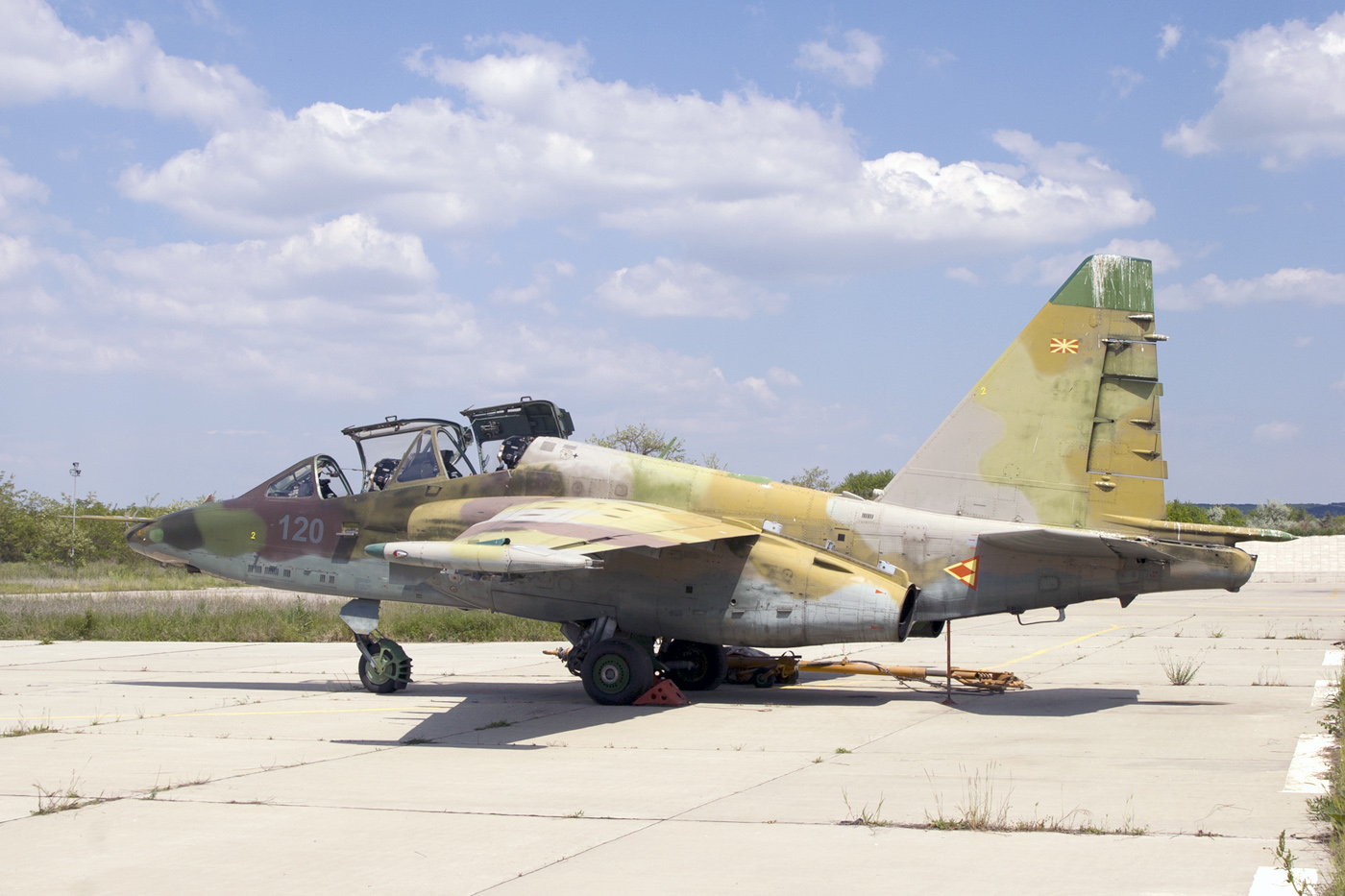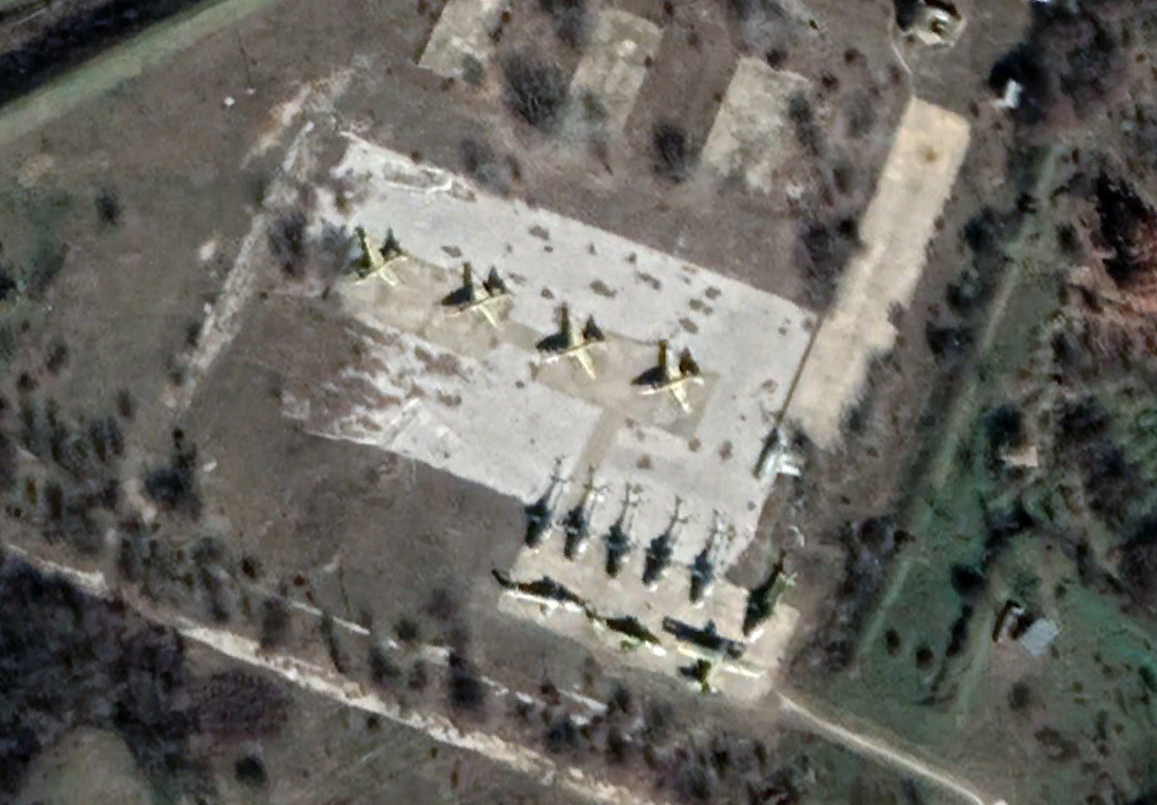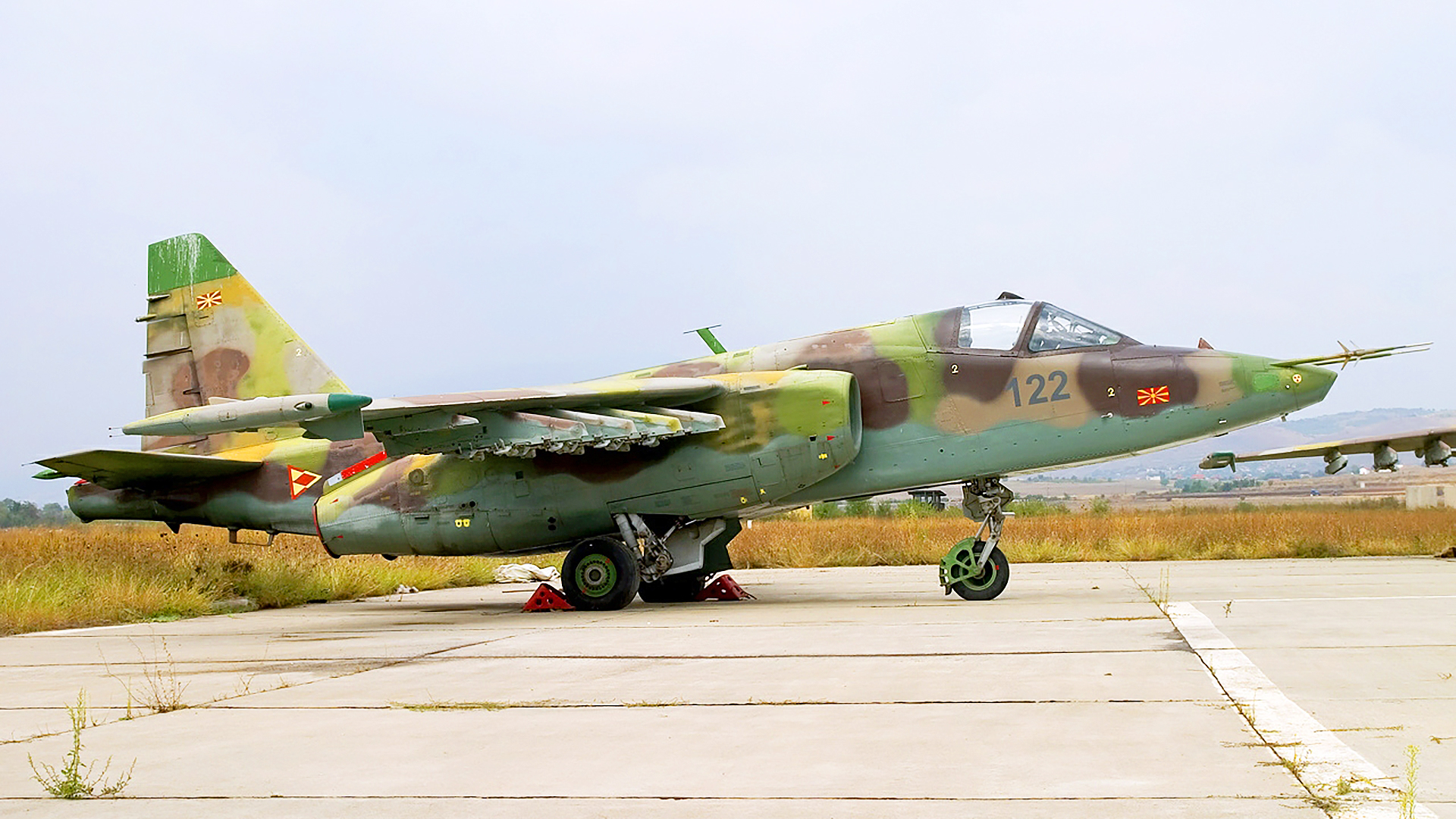Several Ukrainian media outlets have begun reporting that various government entities told them four North Macedonian Su-25 subsonic jet aircraft were recently delivered to Ukraine in some capacity. If true, the jets, three of which originally belonged to Ukraine before 2001, would join the T-72 tanks North Macedonia had donated to Ukraine in July, officially disbanding the country’s only tank battalion. Although, neither the North Macedonian Ministry of Defense nor the Ukrainian Ministry of Defense has released official statements confirming the potential jet transfer.
Macedonia, as it was known at this time, received a rush delivery of four Su-25s in 2001 for use against Albanian insurgents. Three single-seaters from Ukraine and one two-seater from Belarus made up the fleet. The aircraft stopped flying around 2004 and have been left sitting prepared for sale in the open at Petrovec airbase in North Macedonia since then.
The North Macedonian news outlet MKD unofficially cited government sources claiming that Ukrainian military engineers were spotted inspecting and fixing the jets at the airbase in June, however, those reports are unconfirmed.

The War Zone has obtained Google Earth imagery from February that showed the four Su-25s at Petrovec, and Planet Labs imagery continued to place them there up until April. However, the most current Planet Labs satellite data from July shows that the jets are no longer there. This comparison reveals that between the months of April and July, the Su-25s were moved, in one way or another, to an undisclosed location.
This finding could line up with MKD’s claims that the aircraft were spotted undergoing rehabilitation with Ukrainian engineers in June, however, it is important to note that the jets could have also been transported to an additional location to be stripped for parts. When asked about the rumors by MKD, the Ukrainian Ministry of Defense didn’t outright confirm or deny that the transfer of either complete jets or aircraft parts has taken place.

“The exact details of these decisions, their content, and explanation will be declassified and transparently published,” said the Ukrainian ministry. “With the decisions made so far, the combat readiness of our army is not violated.”
The Su-25 is a Soviet-era Sukhoi ground-attack and close-air-support jet that has become a household name throughout the conflict between Russia and Ukraine. Even the Russian Air Force is known to have been operating a number of the Frogfoot jets, rather unsuccessfully at times, and Ukrainian forces also operate the type, often flying at incredibly low altitudes to avoid the threat of Russian air defense systems.
If the Ukrainian Ministry of Defense does, in fact, publish declassified information regarding this potential transfer as they have seemingly committed to doing, The War Zone will be sure to provide an update.
Before we get into more details about the past few days of fighting in Ukraine, you can catch up on our previous rolling coverage of the war here.
The Latest
According to the U.K. Ministry of Defense’s latest defense intelligence update, the intentions of Russian forces as they continue to hold the Zaporizhzhia nuclear power plant in the southeastern city of Enerhodar remain unclear. The ministry insists that the actions Russian forces have taken in the area continue to display a blatant disregard for the safety protocol typically implemented by the International Atomic Energy Agency, which hasn’t been able to visit the plant for routine inspections as the warring countries grapple with who has control of the territory.
A video has also begun circulating on social media that reportedly shows smoke emanating from various sites of Russian shelling near the nuclear power plant. A corresponding article published by Reuters as this piece was being written explains that Energoatom, a Ukrainian state enterprise operating all four nuclear power stations in the country, confirmed this information and blamed Russia for the recent damage inflicted upon the power plant.
“On 5 August, the Russian military again resorted to provocations. As a result of their attack at 14:30, three strikes were recorded near the ZNPP industrial site,” read the Energoatom statement on Telegram. “The enemy hit the high-voltage communication line of the 330 kW switchgear between the ZNPP autotransformer and the Zaporizhzhia Thermal Power Plant.”
Russian forces are almost certainly using the wider facility area as a firebase, thus protecting their artillery systems from a Ukrainian counterattack, as launching one could be of great detriment to the plant. You can read more about the unstable situation at the Zaporizhzhia nuclear power plant in our previous reporting here.
The hazardous operations being carried out near the plant have even prompted some to call upon Amnesty International as the fallout from any major damage done to Zaporizhzhia could quickly become a global catastrophe. The non-governmental organization, which is centered around human rights initiatives, has recently come under fire for sharing a highly controversial report claiming that “Ukrainian forces have put civilians in harm’s way by establishing bases and operating weapons systems in populated residential areas.”
The article goes on to cite that such residential areas include hospitals and schools, and Amnesty International’s Secretary General Agnès Callamard claimed that the organization has “documented a pattern of Ukrainian forces putting civilians at risk and violating the laws of war when they operate in populated areas.” According to the article, these areas were often located kilometers away from the front lines.
The article has sparked such an outcry, in fact, that the Director of Amnesty International in Ukraine Oksana Pokalchuk has since resigned from her position. In a lengthy Facebook post, Pokalchuk, who is Ukrainian, openly criticized the report and cited its publishing as a primary reason for her departure from the organization among other grievances with its leadership.
In better news, three more grain ships departed from Ukrainian ports on Friday carrying thousands of tons of corn. The Associated Press reported that the ships sailed through supposedly mined waters toward inspection sites, and upon approval for passage, will then travel to Ireland, the United Kingdom, and Turkey on the heels of Sierra Leone-flagged ship Razoni. However, many of the transport ships currently full of additional grain harvested in “the world’s breadbasket” remain held in Ukrainian ports.
As part of Canada and NATO’s Operation Reassurance, multiple CF-18 Hornets from Canada’s 425 Tactical Fighter Squadron arrived at the Mihail Kogalniceanu Airbase in Romania beginning July 26. According to a NATO press release, the Canadian Air Force fighter jets will carry out the air policing mission to secure Eastern European airspaces alongside the Romanian Air Force for the next four months.
“Six Royal Canadian Air Force’s CF-188 fighters and personnel from Canada’s Armed Force Air Task Force-Romania (ATF-R) deployed to Romania in early August 2022,” read the NATO press release. “This is the seventh time that Canada has deployed an ATF to Romania on Operation Reassurance since 2014.”
The overall purpose of the deployment is largely similar to the U.S. Air Force’s recent and unprecedented F-22 Raptor arrival in Lask, Poland. The Raptors will be carrying out similar air-shielding operations to deter any possible Russian aggression in the airspace along NATO’s eastern border. You can read more about that here.
The Institute for the Study of War’s (ISW) daily conflict assessment has highlighted a number of areas where Ukrainian forces seem to be gaining ground. For example, ISW reports that the Ukrainian Armed Forces are “likely seizing the strategic initiative and forcing Russia to reallocate forces and reprioritize efforts in response to Ukrainian counteroffensive operations.”
One of the more prominent counteroffensives is purportedly taking place near the city of Kherson. Ukrainian forces are seemingly launching a revitalized effort to take back the region from Russian occupiers, and such claims are only further evidenced by additional ISW reports that Ukrainian forces have allegedly struck two Russian strongholds northwest of Kherson city.
Russian ammunition depots, train stations, and bridges continue to suffer strikes launched by Ukrainian forces, as well. These attacks come amid multiple attempts made by Russian forces to maintain control over occupied territory and continue their advancements, however, ISW notes that many of these efforts have remained just that — attempts. The institute explains that Russians tried to advance northwest of Izyum, but were instead met with a series of localized counterattacks launched by Ukrainian forces to regain positions in various settlements.
After at least two Russian ships were seen smoking off the coast of Crimea yesterday, leading many to suggest that they had been struck by Ukranian missiles, recent reports dictate that the Russian warship of the Vasiliy Bykov class entered Sevastopol bay with her stern’s paint damaged by fire. However, the crux of the incident is still unclear and the ship clearly remains well intact.
Speaking of Russian warships, the country’s navy has seemingly adopted quite an eye-catching and, in some cases, ominous aesthetic. The Russian ‘Z’ is prominently displayed, this time in lights. It is likely that the decorations were part of Russia’s Navy Day parade on July 31.
We will continue to update this post until we state otherwise.
Contact the author: Emma@thewarzone.com
